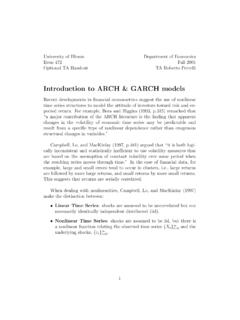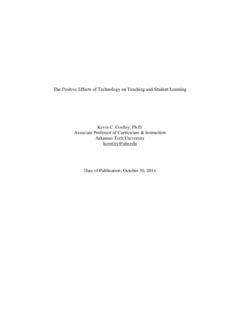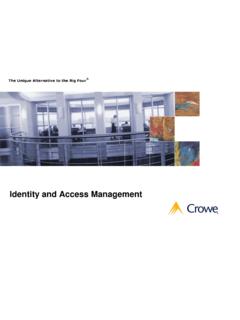Transcription of Quantile Regression - University of Illinois Urbana-Champaign
1 Quantile RegressionRoger Koenker and kevin F. HallockWe say that a student scores at thetth Quantile of a standardized exam ifhe performs better than the proportiontof the reference group ofstudents and worse than the proportion (1 t). Thus, half of studentsperform better than the median student and half perform worse. Similarly, thequartiles divide the population into four segments with equal proportions of thereference population in each segment. The quintiles divide the population into fiveparts; the deciles into ten parts. The quantiles, or percentiles, or occasionallyfractiles, refer to the general case.
2 Quantile Regression as introduced by Koenkerand Bassett (1978) seeks to extend these ideas to the estimation ofconditionalquantile functions models in which quantiles of the conditional distribution of theresponse variable are expressed as functions of observed Figure 1, we illustrate one approach to this task based on Tukey s boxplot(as in McGill, Tukey and Larsen, 1978). Annual compensation for the chiefexecutive officer (CEO) is plotted as a function of firm s market value of equity. Asample of 1,660 firms was split into ten groups of equal size according to theirmarket capitalization.
3 For each group of 166 firms, we compute the three quartilesof CEO compensation: salary, bonus and other compensation, including stockoptions (as valued by the Black-Scholes formula at the time of the grant). For eachgroup, the bow-tie-like box represents the middle half of the salary distributionlying between the first and third quartiles. The horizontal line near the middle ofeach box represents the median compensation for each group of CEOs, and theyRoger Koenker is William B. McKinley Professor of Economics and Professor of Statistics,and kevin F. Hallock is Associate Professor of Economics and of Labor and IndustrialRelations, University of Illinois at Urbana-Champaign , Champaign, Illinois .
4 Their e-mailaddresses of Economic Perspectives Volume 15, Number 4 Fall 2001 Pages 143 156notches represent an estimated confidence interval for each median estimate. Thefull range of the observed salaries in each group is represented by the horizon-tal bars at the end of the dashed whiskers. In cases where the whiskers wouldextend more than three times the interquartile range, they are truncated and theremaining outlying points are indicated by open circles. The mean compensationfor each group is also plotted: the geometric mean as a1and the arithmetic meanasa*.
5 There is a clear tendency for compensation to rise with firm size, but one canalso discern several other features from the plot. Even on the log scale, there is atendency for dispersion, as measured by the interquartile range of log compensa-tion, to increase with firm size. This effect is accentuated if we consider the upperand lower tails of the salary distribution. By characterizing the entire distribution ofannual compensation for each group, the plot provides a much more completepicture than would be offered by simply plotting the group means or we have the luxury of a moderately large sample size in each group.
6 Had wehad several covariates, grouping observations into homogeneous cells, each with asufficiently large number of observations, would become increasingly classical linear Regression , we also abandon the idea of estimating separatemeans for grouped data as in Figure 1, and weassumethat these means fall on a lineor some linear surface, and we estimate instead the parameters of this linear squares estimation provides a convenient method of estimating such condi-Figure 1 Pay of Chief Executive Officers by Firm SizeNotes:The boxplots provide a summary of the distribution of CEO annual compensation for tengroupings of firms ranked by market capitalization.
7 The light gray vertical lines demarcate thedeciles of the firm size groupings. The upper and lower limits of the boxes represent the first andthird quartiles of pay. The median for each group is represented by the horizontal bar in the middleof each :Data on CEO annual compensation from EXECUCOMP in of Economic Perspectivestional mean models. Quantile Regression provides an equally convenient methodfor estimating models for conditional Quantile via OptimizationQuantiles seem inseparably linked to the operations of ordering and sortingthe sample observations that are usually used to define them.
8 So it comes as a mildsurprise to observe that we can define the quantiles through a simple alternativeexpedient as an optimization problem. Just as we can define the sample mean as thesolution to the problem of minimizing a sum of squared residuals, we can definethe median as the solution to the problem of minimizing a sum of absoluteresiduals. The symmetry of the piecewise linear absolute value function implies thatthe minimization of the sum of absolute residuals must equate the number ofpositive and negative residuals, thus assuring that there are the same number ofobservations above and below the about the other quantiles?
9 Since the symmetry of the absolute valueyields the median, perhaps minimizing a sum ofasymmetricallyweighted absoluteresiduals simply giving differing weights to positive and negative residuals wouldyield the quantiles. This is indeed the case. Solvingminj[ Ort~yi2j!,where the functionrt[is the tilted absolute value function appearing in Figure 2that yields thetth sample Quantile as its succeeded in defining the unconditional quantiles as an optimizationproblem, it is easy to define conditional quantiles in an analogous fashion. Leastsquares Regression offers a model for how to proceed.]]
10 If, presented with a randomsample {y1,y2, ..,yn}, we solveminm[ Oi51n~yi2m!2,we obtain the sample mean, an estimate of theunconditionalpopulation mean, we now replace the scalarmby a parametric functionm(x,b) and solveminb[ pOi51n~yi2m~xi,b!!2,we obtain an estimate of theconditionalexpectationfunction E(Yux).1To see this more formally, one need only compute directional derivatives with respect Koenker and kevin F. Hallock145In Quantile Regression , we proceed in exactly the same way. To obtain anestimate of the conditional median function, we simply replace the scalarjin thefirst equation by the parametric functionj(xi,b) and settto12.]]



